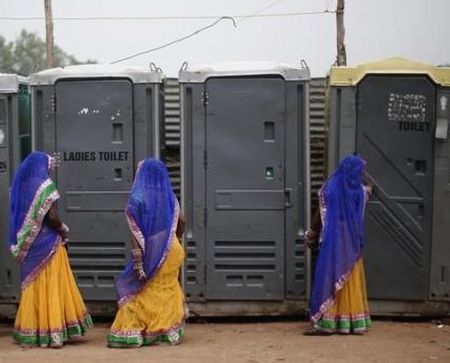 | « Back to article | Print this article |

Less than half the number of toilets targeted were constructed, and a third of those which saw the light of day were defunct. They were either incomplete, or poorly constructed, or badly maintained.
The attempt to make India free of open defecation appears to be a classic example of how goals can remain elusive despite the best of intentions of the government and the availability of money.
The Swachh Bharat Abhiyan, launched by the prime minister over a year ago, is really the fourth avatar of a three-decade long effort.
Yet the fate of the latest repackaging, which has reset the target date at 2019, may not be very different from that of the earlier efforts.
An indication of the mindset at work is available from the fate of a well-meaning effort by the central ministries responsible for various parts of the programme to find out how things are going and learn quick lessons.
But when the quick survey conducted by the National Sample Survey Organisation earlier this year found that less than half the toilets built since the Abhiyan was launched were being used, the government decided to keep the results under wraps lest the Opposition made an issue of it.
Fortunately, a detailed report by the office of the Comptroller and Auditor General into the earlier avatar, Nirmal Bharat Abhiyan, has unearthed highly useful findings which can in fact make it a classic case study.
With rare pungency, the CAG report, covering the period of 2009 to 2014, declares: “The (sanitation) programme which is running in mission mode for three decades has not succeeded in evoking the missionary zeal in various government agencies, participating non-government organisations and corporates.”
The audit found no proper bottom-up planning like gram panchayat plans being linked to district plans.
Less than half the number of toilets targeted were constructed, and a third of those which saw the light of day were defunct.
They were either incomplete, or poorly constructed, or badly maintained.
In the years studied, not only did the Centre release less than half the funds it was to, as many as 16 states either did not release or did less than what was their share of funding.
As the government runs innumerable programmes whose tasks overlap, there was a plan for convergence.
For example, the material cost for toilets in homes built under Indira Awas Yojana could come from the sanitation programme and the labour costs from the rural employment programme -- but this did not happen.
Finally, the programme was to be monitored through an online management information system, but not only was the data uploaded not verified, it was not cross-checked with the departments’ annual performance reports.
A course correction is due.
There may be some change form the past in a critical area -- persuading people to actually use toilets.
Brand ambassadors have been appointed to spread the message.
The NSSO survey has revealed that some are using the new toilets as store rooms.
There is every reason for the government to institute a more detailed study, which discovers the reasons behind the reality, and to shares those results with the public.
Again, money will not be a problem.
The World Bank has approved a $1.5 billion loan to focus on behavioural change to further the project.